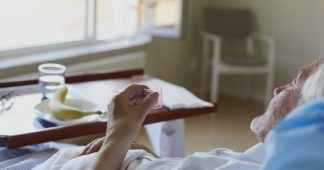By Clare Bruderlin
26 August 2020
The catastrophic spread of COVID-19 throughout more than 130 aged care facilities in the Australian state of Victoria has so far resulted in the deaths of at least 304 residents and over 1,700 infections.
Data from the Victorian Department of Health and Human Services shows that residential aged care accounted for the majority of coronavirus outbreaks between June 1 and August 11. In total, 335 of the 525 people who have died from coronavirus in Australia since the pandemic began were aged care residents.
The pandemic has exacerbated a decades-long crisis. Extensive privatisation and the gutting of public healthcare carried out by successive governments, Labor and Liberal-National alike, has meant that the needs of the elderly and infirm are subordinated to the profit requirements of the corporate and financial elite.
Since 1997, there have been 18 separate government inquiries into residential aged care. An interim report, handed down last year by an ongoing Aged Care Royal Commission, conceded that many of the failings identified in previous inquiries remain widespread.
The decades-long assault on the elderly has created the conditions for the rampant spread of the virus in aged care facilities. Recent reports have revealed catastrophic conditions, including widespread malnutrition, dehydration and untreated sores and infections. Victorian state Labor and federal health authorities blocked some aged-care residents infected with COVID-19 from being transferred to hospital—a policy that amounts to social murder.
One nurse at St Vincent’s hospital in East Melbourne told the Guardian that she treated an elderly resident from the private Kalyna Care facility who was transferred to the emergency department only after she was found with infected wounds and 18 sores on her body. The nurse said the woman had been “left in a room to rot,” and her death last week was “the culmination of six to eight weeks of neglect.”
In the same facility, where more than 20 residents and 15 staff have been infected with COVID-19, photos emerged showing a 95-year-old woman with ants crawling over a wound on her leg.
An audit of Kalyna Care by the aged care regulator some three weeks earlier found that the wounds of residents were not being properly treated, and an Aged Care Quality and Safety Commission assessment team found that the facility failed all five requirements it was tested on. Staff, it stated, did not “have the knowledge and competency to perform their roles effectively.”
However, it was not until Kalyna Care became severely understaffed, as aged care workers were forced into quarantine, that the Victorian government took over the facility and placed residents under the control of a public hospital. The chair of the board of Kalyna Care stated that at one point there was only one nurse and one personal care assistant responsible for 68 residents. Similar tragedies have played out at facilities across Melbourne.
The vast majority of the facilities where outbreaks have occurred, including Kalyna Care, are privately owned and operated, with some of the largest providers amassing millions of dollars in profits each year.
There are around 2,500 aged care facilities in Australia tasked with caring for over 200,000 people. Forty-one percent are owned by private corporations and 50 percent by “not for-profits,” primarily churches and charities. The remaining 9 percent are government owned.
A report released by the Centre for International Corporate Tax Accountability and Research this month revealed that nine of the largest not-for-profit aged care operators, which received $2.4 billion in Government funding in 2019, collectively paid their executives and board members more than $30 million in compensation.
The report also revealed that “while four of the top six operators reported losses in 2019, losses were driven by property investment… Each of the 6 operators generated between $26 million and $62 million in net cash from operations.”
Furthermore, in a recent audit, one of the largest not-for-profit aged care operators, Uniting, which owns more than 70 facilities, was found to have underpaid 9,561 workers in New South Wales and the Australian Capital Territory by more than $3.36 million over the past six year. One worker was underpaid nearly $12,000.
The top six private for-profit aged care providers—Bupa, Opal, Regis, Estia, Japara and Allity—received over $2.17 billion in annual taxpayer subsidies in 2015-16 and made substantial additional operating profits, while paying just $154 million in tax.
According to the Australian Taxation Office, the total combined income of all for-profit aged care providers was over $5 billion in 2015-16, with a total profit of $402 million after tax.
The major windfall to private operators is the direct consequence of the pro-business restructuring of the sector spearheaded by the Labor Party.
In the early 1990s, the federal Labor government of Prime Minister Paul Keating introduced competitive processes for the allocation of funds to aged care and opened up government-funded homes to for-profit organisations. It also pioneered a “user pays” regime by imposing higher fees and introducing entry bonds on residents in aged hostels. By 1997, the number of government-owned aged care facilities had fallen from 19 percent in 1972 to around 11 percent.
The Howard Liberal-National government deepened this process, cutting $1 billion from aged care in the 1996-97 budget, claiming that higher nursing home fees and entry bonds would provide incentives for investors to expand and improve the industry.
In 2011, a Productivity Commission report brought down by the Gillard Labor government made recommendations that the elderly should pay up to 35 percent of their own aged care costs and that these contributions should be funded from the value of their homes, using “reverse mortgages.”
Acting on these recommendations in 2012, the Gillard government released its “Living Longer, Living Better” package, which it said would deliver “a less regulated, more consumer-driven and market-based aged care system.” What this meant, in practice, was that the cost of providing aged care services was substantially shifted onto elderly residents and their families.
Today, aged care residents can expect to pay a basic daily fee of up to $52.25, which is 85 percent of the single person rate of the aged pension, for day-to-day services such as meals, cleaning, facilities management and laundry.
Additionally, there is a “means-tested care fee” for residents which can be up to $259.15 per day. This is used to cover the cost of residents’ personal and clinical care needs which can include help with bathing, dressing, grooming and going to the toilet, specialised nursing services and medication assistance.
Despite the rising cost of care, a 2018 report submitted to the royal commission found that up to half of all residents in aged care facilities suffer from malnutrition as a result of inedible and non-nutritious food coupled with an inadequate number of staff to assist residents who cannot feed themselves.
Another submission found that in 2017, the average food budget in aged care facilities was just $6.08 per resident per day, which was less than the average in Australian prisons ($8.25 per prisoner per day).
Staffing levels in residential aged care in Australia are substantially below those of other comparable countries.
A study carried out for the royal commission released last October, found that per day, aged care residents receive just 36 minutes of care by registered nurses, 8 minutes by allied health professionals and 144 minutes by personal care assistants.
When this was compared with standards in the US, over half (57.6 percent) of Australian residents were found to be in facilities with substandard care. To bring all residential aged care facilities to minimum adequate average staffing levels would require an overall increase of staff by 37.3 percent.
If Australian practices were brought to the standards of Canadian British Columbia, levels of care would have to be increased by 175 percent.
Moreover, the number of higher-trained aged care staff has decreased. In 2003 registered nurses working in aged care accounted for 21.4 percent of the workforce. By 2016 this was reduced to 14.9 percent. The number of less trained personal care attendants, who are often low-paid, casual employees, increased from 56.5 percent in 2003 to 71.5 percent in 2016.
A submission to the royal commission revealed that the present Morrison Liberal-National government was warned in April that aged care facilities would struggle to find staff during a coronavirus outbreak, based on the experience of outbreaks at the Dorothy Henderson Lodge and Newmarch House in Sydney, where an estimated 87 percent of the workforce had to go into quarantine.
Furthermore, aged care workers since March have reported personal protection equipment (PPE) shortages and inadequate infection control.
Despite these warnings, no significant measures have been taken by either state or federal governments to stop the spread of the pandemic in aged care facilities.
On Friday, the Morrison government announced that it would invest $171 million into the aged care sector, claiming this would bring the total investment during the pandemic to $1 billion. However, aged care facilities are not required to report how they are spending this funding.
Jason Ward, of the Tax Justice Network Australia, told the Australian Broadcasting Corporation that while providers have received additional funding during the pandemic, there is “no evidence that they have spent that money in a way that’s been effective in preventing this disease and unnecessary deaths.”
The tragic deaths and illnesses are an indictment of the capitalist system, which subordinates every aspect of life to the profit interests of a tiny corporate elite. As has been the case in Britain and internationally, Australian governments have pursued a homicidal policy of allowing aged care residents to become sick, knowing that many of them would succumb to the virus.
This underscores the fact that the fight for socialism, a society in which social need, not private profit, determines the allocation of resources, is a life and death question.
Published atwww.wsws.org











